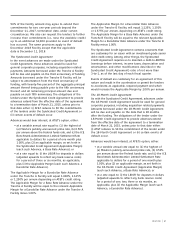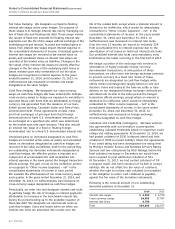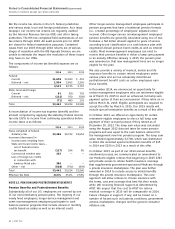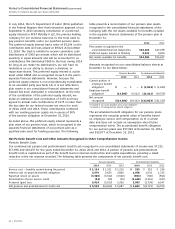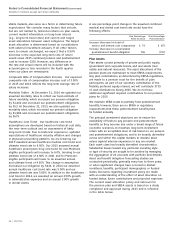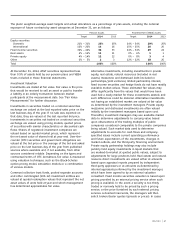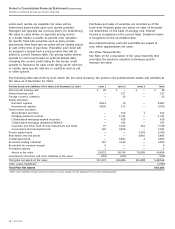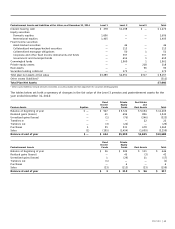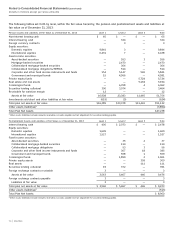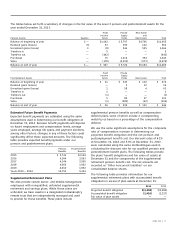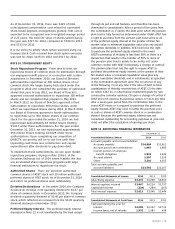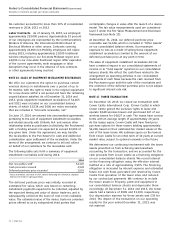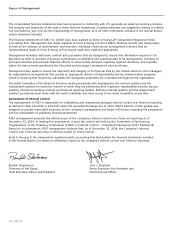AT&T Wireless 2014 Annual Report Download - page 69
Download and view the complete annual report
Please find page 69 of the 2014 AT&T Wireless annual report below. You can navigate through the pages in the report by either clicking on the pages listed below, or by using the keyword search tool below to find specific information within the annual report.
AT&T INC.
|
67
The plans’ weighted-average asset targets and actual allocations as a percentage of plan assets, including the notional
exposure of future contracts by asset categories at December 31, are as follows:
Pension Assets Postretirement (VEBA) Assets
Target 2014 2013 Target 2014 2013
Equity securities:
Domestic 21% – 31% 23% 25% 24% – 34% 29% 25%
International 10% – 20% 14 16 15% – 25% 20 20
Fixed income securities 34% – 44% 38 33 24% – 34% 29 24
Real assets 6% – 16% 11 11 0% – 6% 1 1
Private equity 4% – 14% 12 12 0% – 8% 3 4
Other 0% – 5% 2 3 12% – 22% 18 26
Total 100% 100% 100% 100%
Alternative investments, including investments in private
equity, real estate, natural resources (included in real
assets), mezzanine and distressed debt (included in
partnerships/joint ventures), limited partnership interest,
fixed income securities and hedge funds do not have readily
available market values. These estimated fair values may
differ significantly from the values that would have been
used had a ready market for these investments existed, and
such differences could be material. Alternative investments
not having an established market are valued at fair value
as determined by the investment managers. Private equity,
mezzanine and distressed investments are often valued
initially by the investment managers based upon cost.
Thereafter, investment managers may use available market
data to determine adjustments to carrying value based
upon observations of the trading multiples of public
companies considered comparable to the private companies
being valued. Such market data used to determine
adjustments to accounts for cash flows and company-
specified issues include current operating performance
and future expectations of the investments, changes in
market outlook, and the third-party financing environment.
Private equity partnership holdings may also include
publicly held equity investments in liquid markets that
are marked-to-market at quoted public values, subject to
adjustments for large positions held. Real estate and natural
resource direct investments are valued either at amounts
based upon appraisal reports prepared by independent
third-party appraisers or at amounts as determined by
internal appraisals performed by the investment manager,
which have been agreed to by an external valuation
consultant. Fixed income securities valuation is based upon
pricing provided by an external pricing service when such
pricing is available. In the event a security is too thinly
traded or narrowly held to be priced by such a pricing
service, or the price furnished by such external pricing
services is deemed inaccurate, the managers will then
solicit broker/dealer quotes (spreads or prices). In cases
At December 31, 2014, AT&T securities represented less
than 0.5% of assets held by our pension plans and VEBA
trusts included in these financial statements.
Investment Valuation
Investments are stated at fair value. Fair value is the price
that would be received to sell an asset or paid to transfer
a liability in an orderly transaction between market
participants at the measurement date. See “Fair Value
Measurements” for further discussion.
Investments in securities traded on a national securities
exchange are valued at the last reported sales price on the
last business day of the year. If no sale was reported on
that date, they are valued at the last reported bid price.
Investments in securities not traded on a national securities
exchange are valued using pricing models, quoted prices
of securities with similar characteristics or discounted cash
flows. Shares of registered investment companies are
valued based on quoted market prices, which represent
the net asset value of shares held at year-end. Over-the-
counter (OTC) securities and government obligations are
valued at the bid price or the average of the bid and asked
price on the last business day of the year from published
sources where available and, if not available, from other
sources considered reliable. Depending on the types and
contractual terms of OTC derivatives, fair value is measured
using valuation techniques, such as the Black-Scholes
option pricing model, simulation models or a combination
of various models.
Common/collective trust funds, pooled separate accounts
and other commingled (103-12) investment entities are
valued at quoted redemption values that represent the net
asset values of units held at year-end which management
has determined approximates fair value.


